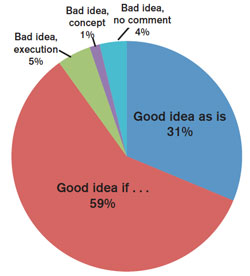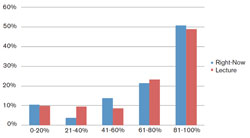
| Vol.
XXV No.
4 March / April 2013 |
| contents |
| Printable Version |
Teach Talk
Dialog on Right-Now Talks
Through an accident of nature, no recitation instructors were available this past term for 6.034, Introduction to Artificial Intelligence. My TAs and I wondered how we could make up for the enrichment function normally provided in weekly recitations. We decided to add “right-now” talks. On eight Fridays, we had inspirational MIT faculty and staff talk about what they were doing in their research right now. We aimed to schedule the right-now talks so that they demonstrated that the skills and concepts I was teaching are relevant to current research and practice.
To get feedback, we asked a few questions on the cover page of our final. The results seemed to invite discussion at the Galileo Society. Segredo represented the staff.
Simplicio: I've heard about Winston's experiment. Wasn't this just making a subject out of a set of guest lectures?
Segredo: Winston still gave his usual lectures on Mondays and Wednesdays, so there were still distinct syllabus-grounded lectures. The right-now talks were condiments.
Simplicio: How did the students react to the right-now talks?
Segredo: Well, we ran a survey, asking the students to choose among (1) Good idea as is, (2) Would be a good idea if..., and (3) Bad idea. We think 95% fell on the spectrum from not completely against the concept to wildly enthusiastic.
Salviati: What? It looks like 90% to me.
Segredo: You have to squint. Of 288 registered students, 223 chose to try to improve their grades by taking the final. Of the 223, 96% answered the question. Of these, 31% indicated they like the right-now idea as is. Another 59% suggested improvements. That brings us to 90%.
Salviati: OK, so how did you get beyond that?
Segredo: We looked carefully at the volunteered comments of the students who checked Bad idea. Nine wrote that they vigorously disliked the execution, but said nothing about disliking the concept. Three others didn't like the concept: one wrote that he didn't get anything out of the talks; another wrote that he didn't have the right background; and a third wrote he had trouble with the English. So of those 12 who checked Bad idea and said why, three-fourths complained about execution rather than concept, with comments much like those who checked Would be a good idea if.... Taking the nine as not completely against the concept gets us to 95%.
Salviati: You can't say 95%!
Segredo: Right, we only think it. But 90% is still an impressive number.
Simplicio: What were the suggestions?
Segredo: There were 132; 42% wanted changes in the way we asked questions about the right-now content in our exams.
We just wanted to encourage students to attend and pay attention, so we asked multiple choice questions that we thought would be exceedingly easy for those who attended and paid attention. Here is an example:
Sussman's propagator architecture is motivated, in part, by his interest in problems such as:
- Harnessing the power of cloud computing.
- Harnessing the power of crowd sourcing.
- Calculating the distances to galaxies.
- Modeling the propagation of rumors spreading through social media.
- All of the above.
- None of the above.
Sussman talked for 20 minutes about galaxies and said nothing at all about cloud computing, crowd sourcing, or rumors.
Salviati: So everyone got those kinds of questions right?
Segredo: No, many found them difficult and complained. We soon got rid of the All of the above and None of the above options, which everyone hated, but still, some said they attended faithfully and tried hard, but still bombed. The fact is, there is a lot of fogging out in lectures of any kind. Next time, we will teach some techniques for increasing absorption and retention.
Salviati: Like what?
Segredo: Taking structured notes and telling someone about the talk right afterward.
Simplicio: Why bother? MIT is moving to lecture-free MITx, after all.
Segredo: We don't think research talks and business pitches will move toward 12-minute chunks with gating questions in between.
Simplicio: Why didn't you ask open-ended questions?
Segredo: It would have taken forever to grade them. Besides, our quizzes are chocked full with our regular material, so we had to have rapidly-answerable questions.
Salviati: What other suggestions were there?
Segredo: 22% wanted fewer points allocated to the material. We allocated 2/7 of each student's total score to questions covering the eight right-now lectures and another eight given by me that had an enrichment flavor. We might go a little lower, but we think we would soon get low enough that no one would show up. We are competing with other subjects for our students' time, after all.
Simplicio: So how many showed up?
Segredo: Have a look at how the students responded to an attendance question in our survey. About 50% of the students claimed they went to at least 80% of the regular lectures and the right-now talks; more than 70% went to most of them.
Simplicio: Why didn't you just take attendance?
Segredo: The look and feel of attendance taking seems wrong. Besides, you can attend and not pay attention.
Simplicio: Why are you so sure attendance would have dropped without testing?
Segredo: Well, we offered a totally optional Friday afternoon one-hour session focused on discussing the material covered by that day's right-now speaker. Typically, about 10 students came.
Salviati: What else did the students say they wanted?
Segredo: 12% wanted notes. Another 4% wanted the talks to be available online. But notes and recordings would discourage showing up.
Simplicio: So what?
Segredo: No inspiration. No practice in getting something out of a research talk. Speaker recruiting would become impossible.
Simplicio: What about the rest of the suggestions?
Segredo: In the miscellaneous category, perhaps the most interesting suggestion was that we threaten to ask questions about the right-now talks, but not actually do it.
Others suggested that we provide previews before the right-now talks, discuss them in tutorials afterward, and supply food during.
Salviati: Any big surprises?
Segredo: Not a big surprise, but although there were lots of complaints about our testing, no one volunteered that our testing uncovered a personal absorption and retention problem.
Salviati: Will you do it again, with adjustments?
Segredo: Definitely. The idea emerged from an accident, but the right-now idea plays on the question of where the value-added will be when much of skill teaching moves to MITx and its analogs. At least part of the value-added will be inspiration from inspiring live speakers and a sense of being at a place where interesting and important things are happening. We have to find all sorts of ways to amplify that part of the experience.
| Back to top | |
| Send your comments |
| home this issue archives editorial board contact us faculty website |

